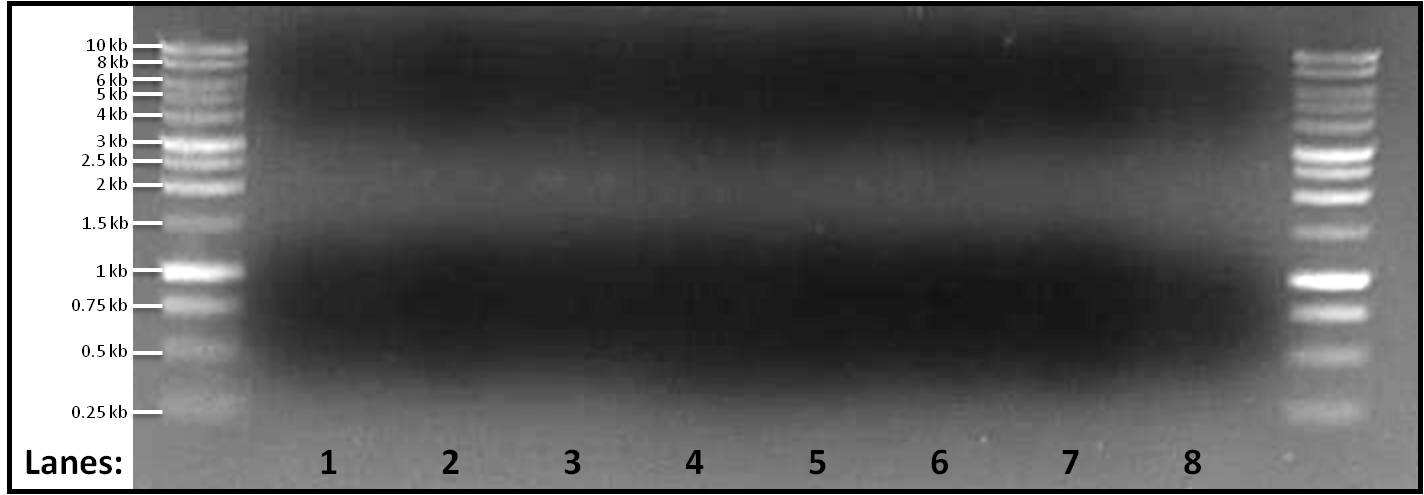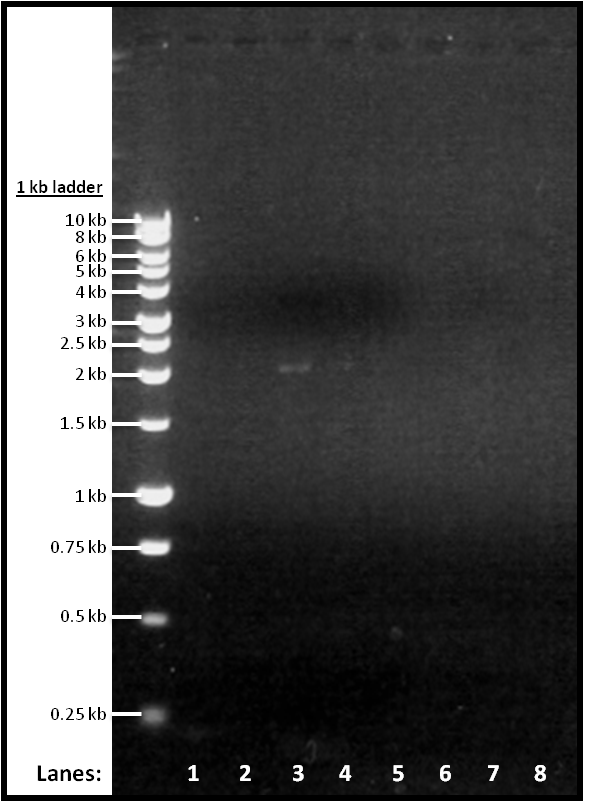Team:Newcastle/23 August 2010
From 2010.igem.org
(→Result) |
(→Aims) |
||
| Line 32: | Line 32: | ||
==Aims== | ==Aims== | ||
| - | The aim of this experiment is to run gel electrophoresis for the extracted and linearized plasmid pSB1C3 fragment which were amplified at 4 different melting temperatures by 4 separate PCR reactions and to put Ethidium | + | The aim of this experiment is to run gel electrophoresis for the extracted and linearized plasmid pSB1C3 fragment which were amplified at 4 different melting temperatures by 4 separate PCR reactions and to put Ethidium Bromide (EtBr) in the agarose gel instead of safeview die so as to get better resolution and brighter bands. |
==Materials and Protocol== | ==Materials and Protocol== | ||
Revision as of 09:05, 26 August 2010

| |||||||||||||
| |||||||||||||
Contents |
pSB1C3 plasmid gel electrophoresis
Aims
The aim of this experiment is to run gel electrophoresis for the extracted and linearized plasmid pSB1C3 fragment which were amplified at 4 different melting temperatures by 4 separate PCR reactions.
Materials and Protocol
Please refer to: gel electrophoresis for gel electrophoresis protocol.
Result
Figure 1: Gel electrophoresis of the amplified linearized plasmid pSB1C3 fragments ran at 4 different melting temperatures, Tms, (50, 60, 65, 70°C). A 1 kb DNA ladder was used on either side of lanes.
- Lane 1: pSB1C3 fragment amplified at 55°C
- Lane 2: pSB1C3 fragment amplified at 60°C
- Lane 3: pSB1C3 fragment amplified at 65°C
- Lane 4: pSB1C3 fragment amplified at 70°C
- Lane 5: pSB1C3 fragment amplified at 55°C
- Lane 6: pSB1C3 fragment amplified at 60°C
- Lane 7: pSB1C3 fragment amplified at 65°C
- Lane 8: pSB1C3 fragment amplified at 70°C
Discussion
No bands were found in any of the lanes. Yesterday, a faint band was found when the melting temperature was set at 65°C but today no band is found in lane 3 and lane 7. This makes finding the cause for no amplification even difficult. We would still be looking into it and would be changing other parameters.
Conclusion
The PCR reaction failed as there is no amplification found in any of the reactions.
pSB1C3 plasmid gel electrophoresis by adding EtBr
Aims
The aim of this experiment is to run gel electrophoresis for the extracted and linearized plasmid pSB1C3 fragment which were amplified at 4 different melting temperatures by 4 separate PCR reactions and to put Ethidium Bromide (EtBr) in the agarose gel instead of safeview die so as to get better resolution and brighter bands.
Materials and Protocol
Please refer to: gel electrophoresis for gel electrophoresis protocol.
Please note that in this protocol we have made a minor modification which is that instead of adding 5µl of safeview dye, we have added 5µl of EtBr into the agarose gel so as to get better resolution and brighter bands.
Result
Figure 2: Gel electrophoresis (containing EtBr) of the amplified linearized plasmid pSB1C3 fragments ran at 4 different melting temperatures, Tms, (50, 60, 65, 70°C). A 1 kb DNA ladder was used on either side of lanes.
- Lane 1: pSB1C3 fragment amplified at 55°C
- Lane 2: pSB1C3 fragment amplified at 60°C
- Lane 3: pSB1C3 fragment amplified at 65°C
- Lane 4: pSB1C3 fragment amplified at 70°C
- Lane 5: pSB1C3 fragment amplified at 55°C
- Lane 6: pSB1C3 fragment amplified at 60°C
- Lane 7: pSB1C3 fragment amplified at 65°C
- Lane 8: pSB1C3 fragment amplified at 70°C
Discussion
No bands were found in any of the lanes. Yesterday, a faint band was found when the melting temperature was set at 65°C but today no band is found in lane 3 and lane 7. This makes finding the cause for no amplification even difficult. We would still be looking into it and would be changing other parameters.
Conclusion
The PCR reaction failed as there is no amplification found in any of the reactions.
Amplification of linearized plasmid pSB1C3 by PCR
Aim
The aim of this experiment is to amplify plasmid linearized pSB1C3for the construction of rocF BioBrick with the help of 5 different Phusion PCR.
Materials and Protocol
Please refer to PCR for Phusion PCR protocol. The details for the 5 PCR reactions are mentioned below:
PCR
| Tube | Part to be amplified | DNA fragment consisting the part | Forward primer | Reverse Primer | Melting Temperature (Tm in °C) | Size of the fragment (in bp) | Extension time* (in seconds) |
|---|---|---|---|---|---|---|---|
| 1 | plasmid pSB1C3 without rfp insert | plasmid pSB1C3 | P1P1 forward (new) | P2P1 reverse (new) | 63 | 2072 approx. | 65 |
| 2 | plasmid pSB1C3 without rfp insert | plasmid pSB1C3 | P1P1 forward (new) | P2P1 reverse (new) | 64 | 2072 approx. | 65 |
| 3* | plasmid pSB1C3 without rfp insert | plasmid pSB1C3 | P1P1 forward (new) | P2P1 forward (new) | 65 | 2072 approx. | 65 |
| 4 | plasmid pSB1C3 without rfp insert | plasmid pSB1C3 | P1P1 forward (new) | P2P1 forward (new) | 66 | 2072 approx. | 65 |
| 5 | plasmid pSB1C3 without rfp insert | plasmid pSB1C3 | P1P1 forward (new) | P2P1 forward (new) | 67 | 2072 approx. | 65 |
Table 1: Table represents 5 different Phusion PCR reactions for the amplification of linearized plasmid pSB1C3, so that it can be ligated together with other fragments for the construction of rocF with the help of Gibson Cloning method.
- For the 3rd PCR reaction where the melting temperature is set for 65°C, the number of cycles were increased to 35 instead of 29.
- The extension rate of the Phusion polymerase is 1Kb/ 30 seconds. Thus the extension time of each and every PCR reaction is slightly different.
- For learning about the rocF fragments, please refer to the Cloning strategy for rocF.
Discussion
All the 5 Phusion PCR reactions were done however, gel electrophoresis will be done tomorrow, to check whether the fragments have actually amplified or not.
Conclusion
Today afternoon, we would be running gel electrophoresis to check the outcome of the 5 PCR reactions and later all the fragments will be ligated with help of Gibson protocol if the fragments have amplified.
pSB1C3 plasmid gel electrophoresis
Aims
The aim of this experiment is to run gel electrophoresis for the extracted and linearized plasmid pSB1C3 fragment which were amplified at 5 different melting temperatures by 5 separate PCR reactions.
Materials and Protocol
Please refer to: gel electrophoresis for gel electrophoresis protocol.
Result
Figure 3: Gel electrophoresis of the amplified linearized plasmid pSB1C3 fragments ran at 5 different melting temperatures, Tms, (63, 64, 65, 66 and 67°C). A 1 kb DNA ladder was used on either side of lane 1 and lane 8.
- Lane 1: pSB1C3 fragment amplified at 63°C
- Lane 2: pSB1C3 fragment amplified at 64°C
- Lane 3: pSB1C3 fragment amplified at 65°C
- Lane 4: pSB1C3 fragment amplified at 66°C
- Lane 5: pSB1C3 fragment amplified at 67°C
Discussion
No bands were found in any of the lanes. Yesterday, a faint band was found when the melting temperature was set at 65°C but today no band is found in lane 3 . This makes finding the cause for no amplification even difficult. We would still be looking into it and would be changing other parameters.
Conclusion
The PCR reaction failed as there is no amplification found in any of the reactions.
yneA
Setting up Overnight Cultures
Aim
To prepare overnight cultures for miniprep tomorrow.
Materials and Protocol
Please refer to growing an overnight culture.
Go back to our main Lab book page
 
|
 "
"

